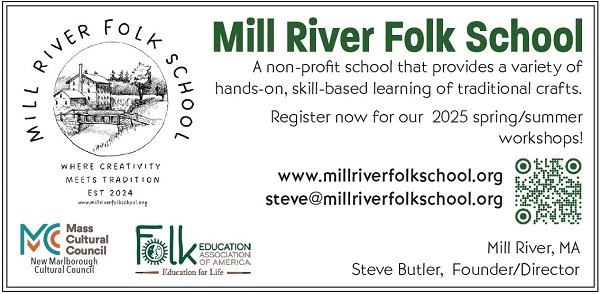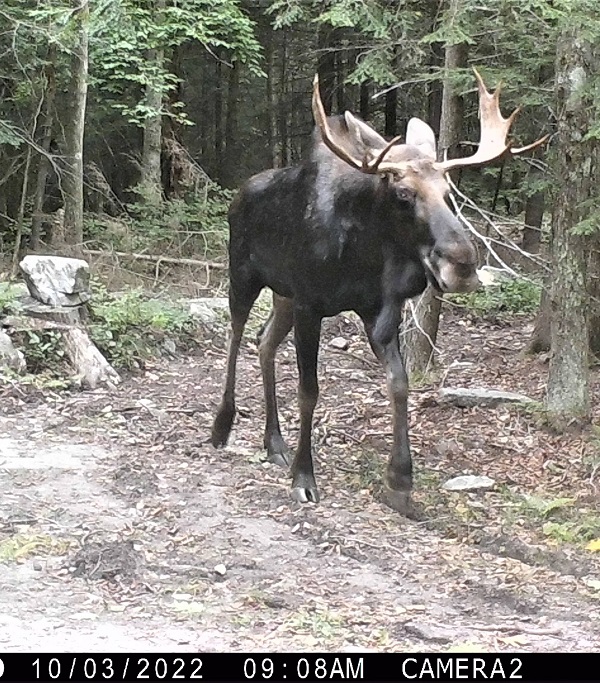| The Sandisfield Times |
|---|
| Our Neighbors, the Moose
They're Here, Just Wait. You'll See One. |
|
By Tom Christopher Published June 1, 2025. |
|
A couple of weeks ago I had an experience that was exciting for me and thrilling for my dog Finn, although not terribly uncommon in Sandisfield. Finn and I stepped outside after lunch, he to resume nagging me to throw a ball for him to retrieve and me to return to my labors in the vegetable garden. First, though, we were confronted by a cow moose, standing about forty feet away on the lawn as she checked out our landscape. Finn was gobsmacked. He barks ferociously when he smells or sees the bear which occasionally cuts through our yard, but at the sight of the moose, he just barked once or twice and then stood transfixed. He'd never seen an animal so large. The moose gave Finn a look and then, without hurrying, turned around and trotted back down the path to our beaver pond. Finn wanted to follow, but fortunately he listened to my recall. My thought was that the moose, though she had behaved remarkably patiently so far, might react badly to harassment. I'm old enough (71 as of this past May) to remember when moose sightings were limited to the very northern portions of New England, so they still make my heart beat faster when they visit our Sandisfield property. They should excite you too because they signify some important changes in the local landscape. They Were Here First Moose aren't exactly newcomers - they had roamed throughout Massachusetts until the early 1700s when clearing of the forests combined with unrestricted hunting extirpated them from our state. It wasn't until the 1980s that moose returned to southern Berkshire County. In pre-colonial times, Sandisfield had been toward the southern limit of moose's range and they were not plentiful here. They evolved as creatures of the northern forests; their long legs help them not only in wading through swamps but also in walking through deep snow. Yet they now find our region more hospitable in some respects than their northern heartland. That's because the warming of the climate up north has favored the spread of winter ticks and fatal diseases such as brain worm, particularly in areas densely populated by moose. According to John F. Organ, adjunct associate professor at the University of Massachusetts School of Natural Sciences, such pests and diseases are less likely to spread in regions sparsely populated by moose such as ours. Plus, the return of wolves to the moose's' more northerly habitats together with hunting by human hunters has further reduced their numbers there. Without predators or a moose hunting season, Massachusetts is more favorable to moose survival, as is our patchier landscape. We don't have broad stretches of ideal moose habitat, but we do have intermittent areas of closely mingled patches of wetlands and densely canopied mature forest for them to retreat to during hot weather, as well as, thanks to timber harvesting, lots of young forest to provide them with browse. Moose will probably never be abundant in Sandisfield, but they seem likely to thrive here in modest numbers. Is there any downside to this? Potentially. Moose can be aggressive when disturbed, especially during the males' fall rutting season (sound familiar?), or when females are protecting their calves. They are best viewed from what Mass Wildlife describes as a "respectful distance." If encountered up close, you should back off, trying not to startle them, and keep your dog under control. The more serious threat, though, is to motorists. Adult moose are tall enough that when struck by a car or pickup, the mass of their bodies is likely to come through the windshield or crush the vehicle's roof, with predictable results. I learned about this hazard during a long ago visit to Newfoundland, a place that had never had an indigenous population of moose until 1904, when the Canadian government released four individuals in the hope that they would reproduce and attract big game hunters. This was just seven years before a longstanding campaign of trapping, poisoning, and shooting succeeded in killing the last known wolf on the island. Today, there are an estimated 150,000 moose roaming that small province and far too few hunters, so the main brake on further moose population growth is collisions with cars. These number on average 1.5 per day in that very thinly populated region and locals insist that statistic doesn't reflect the real toll as such accidents often go unreported. A common sight on the Newfoundland highways is trucks with tubular steel "moose bumpers" mounted on the front. Other motorists commonly avoid driving at night and especially during the hours around dawn and sunset when these crepuscular animals are typically on the move. The upside of such a collision, according to my wife Suzanne who pursued research for a graduate geology degree in Newfoundland, is that such encounters commonly become the occasion for a festive communal dinner of moose stew. The hours of darkness, dawn and twilight would also be a good time for motorists in Sandisfield to slow their speed and stay extra alert, especially when passing through areas that moose are known to inhabit. True, there's a lot of meat on a moose. Even the most festive pot of stew, however, can come at too high a price. |

|
©The Sandisfield Times. All rights reserved.
Published June 1, 2025
